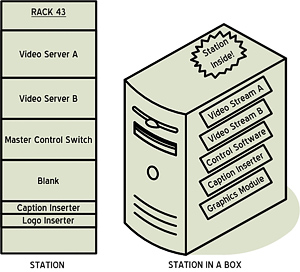The Future is Yours!

Lao Tzu, the father of Taoism, said, "Those who have knowledge, don't predict. Those who predict, don't have knowledge."
Perhaps I will be getting myself into trouble, but I think it is time for a few predictions. It used to be that, when wandering through the NAB Show, it seemed to be difficult to guess what would be around the next corner. Maybe I am more jaded, but it seems that several near-term trends for IT in media are a little more predictable despite the apparent pace of change.
Web 2.0 is almost certainly a term you have come across.
The following is a tiny fraction of the interesting Web 2.0 sites that are available to whet your appetite.
Facebook (www.facebook.com)
MySpace (www.myspace.com)
LinkedIn (www.linkedin.com)
SMPTE 365 (365.smpte.org)
NAB 365 (nab365.com)
Digg (digg.com)
Ning (www.ning.com)
Some of you may already interact with some of these sites. Web 2.0 is sometimes called the "social Web" or the "read/write Web." At this point the importance of Web 2.0 sites and concept is unquestionable. What is a question is what you should be doing.
Without a doubt you should be doing something useful. Web 2.0 not only has the power to influence how your viewers interact with you, but also how your employees interact with each other and the information they manage.
Inside a company, Web 2.0 meets business intelligence in a technology concept known as the "mash-up." Mash-ups are user-defined applications that combine the functionality of multiple other applications, exposed as services. These hybrids are essentially composite services, in that they take basic business functionality from Web 2.0 software companies such as Google and Flickr and orchestrate them together to create new and useful functionality with little or no interaction by software developers.
BUSINESS FUNCTIONALITY
Providing programmatic hooks into business functionality in media is a good way to encourage resource reuse and innovation.
For example, an asset management system at a cable network could expose semantic metadata about production media and combine it with rundown information on the assets being aired. Then a sales department could write a mash-up that lists topics for each hour of broadcast, making it possible to cater their ad sales to this list to make them even more relevant. They would be able to do this on their own, without the involvement of an enterprise integration department or team.

One excellent example of the collapse of the media hardware infrastructure into software is "station in a box" systems. Another trend in the IT industry that will slowly seep over to the media industry as well is the simultaneous proliferation of smaller standards and decreasing necessity of complex standard data representation.
This trend will increase the importance of parsing meaning out of many disparate standards that will exist in a facility. This is where semantic technologies can help.
Semantic technologies attempt to capture the true, human-understandable meaning behind all of those countless metadata standards and models. Semantics would capture that "number of frames," "duration," and "total run time" are all representing the same kinds of information about an asset.
There are two standards in this area already that show great promise in enabling the so-called "Semantic Web" or Web 3.0: RDF (the resource description framework) and OWL (Web Ontology Language).
Perhaps most interestingly, there is an important trend in the media industry today that has never occurred in the IT industry due to the fact that IT has basically been all about software since its inception. That trend is the collapsing of media hardware chains into software.
REDUCED TO ONE
Since the beginning of the modern media industry, engineers and other media professionals have needed separate, specialized equipment for production that was custom-built, expensive, and not that useful for anything other than its specific purpose. The technology of film- and tape-based production has given way to the video servers and nonlinear editing systems of file-based production, but the same fact remains: production technology is often custom-purpose and dedicated.
This is changing. As software-based systems become more prevalent in the M&E industry, they will be replacing, in many cases, dedicated hardware-based systems.
One excellent example of the collapse of the media hardware infrastructure into software is "station in a box" systems (Fig. 1). This was also seen a great deal in the audio industry over the last couple of decades. What used to be separate processing boxes has now become one. There are multiple areas of our industry where this is happening.
You can expect the future to bring greater and greater functionality into single integrated packages. An advantage to this is the decreasing importance of integration, but vendor lock-in and dependence may become a greater issue.
"Trying to predict the future is like trying to drive down a country road at night with no lights while looking out the back window," said writer Peter Drucker.
It might be more difficult, but if you can predict where your technology needs to head next, you can certainly make your job easier. You can Count on IT!
John Footen is a vice president at National TeleConsultants and the head of its Software Solutions Group. He is also co-author of the book, "Service-Oriented Media Enterprise." He can be reached atjfooten@ntc.com.
Get the TV Tech Newsletter
The professional video industry's #1 source for news, trends and product and tech information. Sign up below.
With more than three decades of M&E experience under his belt, John Footen is a managing director who leads Deloitte Consulting LLP’s media technology and operations practice. He has been a chairperson for various industry technology committees. He earned the SMPTE Medal for Workflow Systems and became a Fellow of SMPTE. He also co-authored a book, called “The Service-Oriented Media Enterprise: SOA, BPM, and Web Services in Professional Media Systems,” and has published many articles in industry publications.

